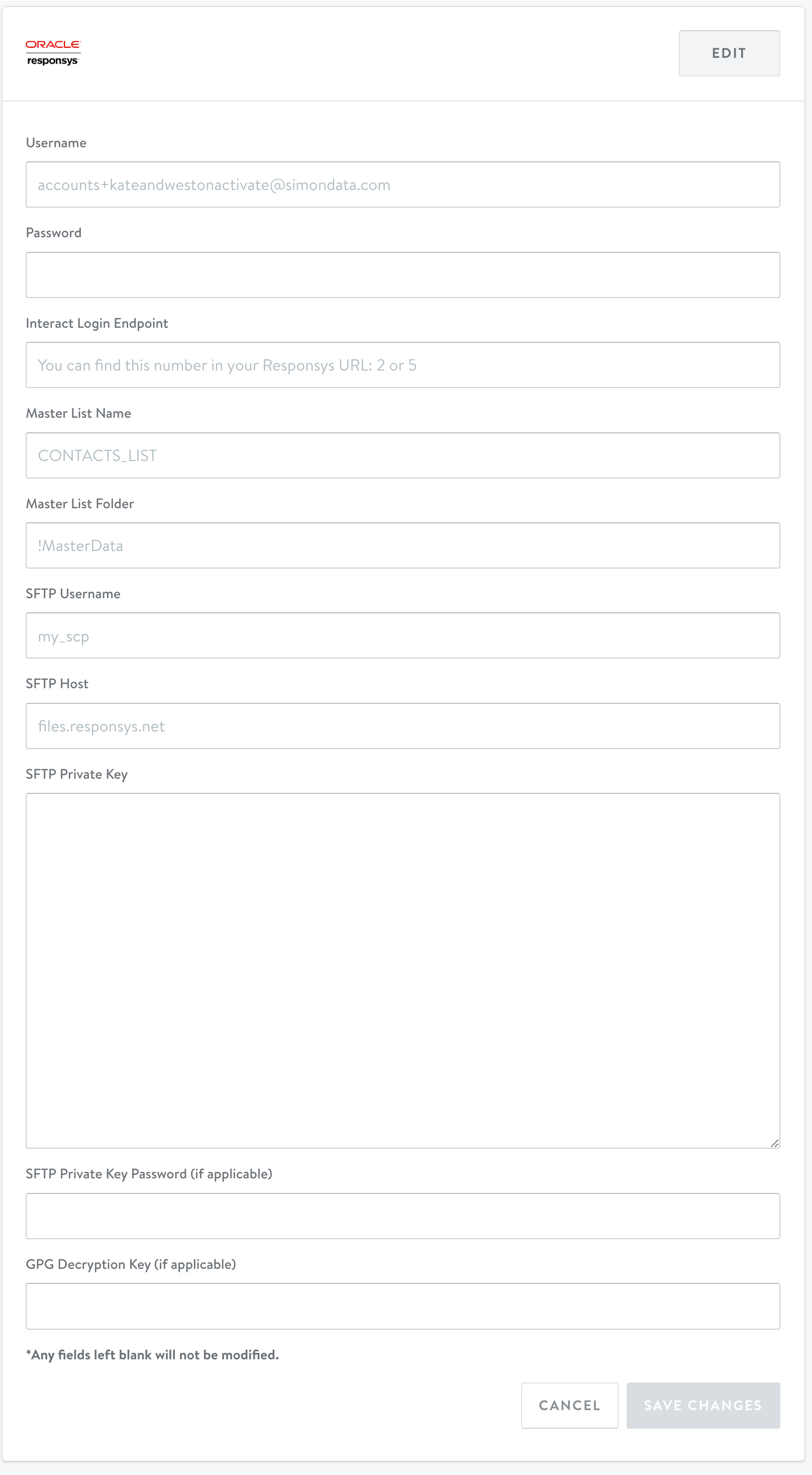Oracle Responsys
Overview
Simon connects to Oracle Responsys so you can send triggered emails and sync content to your Responsys profile extension tables (PET).
Use Cases
- Automate core lifecycle email campaigns based on change in segment state
- Drive rich personalized emails based on customer data and custom content
Getting Started
Understanding Lists & Profile Extension Tables
Marketing channels keep master lists of contacts. Responsys calls these Profile Lists. These lists can be large. Every extra piece of new information per customer can slow things down exponentially. To solve this, channels may use smaller, lighter tables as addendums to your main table to store these extra details about your customers so you can more nimbly retrieve the most relevant information. In Responsys, these are known as Profile Extension Tables (PET).
Profile Extension Tables are used to "store additional attributes that define behavioral, demographic or profile preference characteristics of your contacts" and are filterable. Visit the Responsys Help Center to learn more about PETs.
We sync to Responsys Profile Extension Tables (PET) so that you can leverage this extra data when targeting your customers and orchestrating your campaigns.
Set up Syncing
To prepare Responsys for syncing:
- Setup a PET in Responsys - You first need to Create a PET, in Responsys, with one column that corresponds to each column in custom contexts. All fields in that PET should be set up as a Long Text data type.
- Ensure your contacts exist in Responsys - To sync a contact from Simon to a PET in Responsys, the contact must already exist in Responsys with an assigned Recipient ID (RIID), a unique identifier assigned in Responsys and found in a profile list. Without a RIID we can't sync the contact and it'll be skipped.
- Ensure your contacts in Responsys have an email address - In Responsys, the contact must also have email address in the PET or list chosen for sync'ing. Without an email address, an email message will not be sent.
- Choose the action - When building flows in Simon, use the Responsys PET action that works with your organization's setup and needs
Considerations
- Data Ingestion Timelines - Data is ingested from Responsys hourly, so if you recently added a new template or table it may not be available to you right away in Simon.
- One-to-One Identifiers - We highly recommend contacts have one email per RIID. Responsys sends email through an operation that merges contacts. RIIDs with multiple emails addresses cause issues and if multiple recipients are found we can't send a message to any of those emails associated with that RIID.
- PET Expirations - If you set a PET to expire in Responsys, you also need to stop the corresponding flow in Simon (flows don't have an end date concept so this has to happen manually). To help track this, you can configure alerts in Simon to be notified if the PET is missing.
Authentication

- From the left navigation, expand admin, then click integrations.
- Scroll to Oracle Responsys then complete the following fields:
| Field | Description |
|---|---|
| Username | The username used to log in to Responsys's web application |
| Password | The password used to log in to Responsys's web application |
| Interact Login Endpoint | Responsys hosts their software on multiple instances. This field refers to the instance you access, likely either 2 or 5. Review Oracle's guide here. |
| Master List Name | The name for the main Profile List that contains the contacts that Simon will sync. |
| Master List Format | The name for the folder that contains the data Simon (e.g. Lists, Profile Extensions) will interact with. |
| SFTP Username | The Responsys SFTP server password |
| SFTP Host | The Responsys SFTP server URL |
| SFTP Private Key | The public and private key you generate for Responsys' SFTP server. Responsys is given the public key. Review Oracle's guide here. |
| SFTP Private Key Password (if applicable) | The public and private key you generate for for Responsys' SFTP server. Responsys is given the public key. Review Oracle's guide here. |
| GPG Decryption Key (if applicable) | If necessary, this is the key you use to encrypt the SFTP payload. |
Action Types
| Action | Function | Activate Flows | Journeys | One-Time | Triggered | Stream | Recurring |
|---|---|---|---|---|---|---|---|
| Send Triggered Email To Contact | Send triggered messages to your contacts using one of your Oracle Responsys templates. | ❌ | ✅ | ✅ | ✅ | ❌ | ✅ |
| Sync Contact to Profile Extension Table (PET) | Add or remove contacts from a PET | ✅ | ✅ | ✅ | ✅ | ✅ | ✅ |
| Add to and Update Profile Extension Table (PET) | Update contacts in a PET | ❌ | ❌ | ✅ | ❌ | ❌ | ✅ |
| Upsert to Profile Extension Table (PET) | Adds, update, or remove contacts from Responsys PETs. | ✅ | ❌ | ❌ | ❌ | ❌ | ❌ |
Updated 2 months ago
